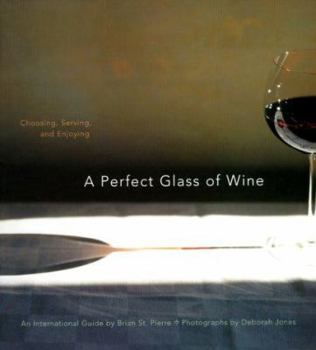A Perfect Glass of Wine: Choosing, Serving, and Enjoying
Many people see the enjoyment of wine as an intimidating and complicated matter, requiring a mastery of arcane rules and rituals. In fact, there's no more to it than putting each wine to the ultimate test: Does it taste good? Wine writer Brian St. Pierre's book begins by introducing the basic flavors of the several grape varieties used in making wines around the world. Once those are understood, all the rest flows smoothly - what distinguishes the colors and types, how to match wine withfood, how to store and serve it, and even how much to spend on a bottle. St. Pierre's sensible approach combined with stunning photographs and elegant maps of the world's great wine-growing regions make this the perfect no-nonsense guide or lovely gift for anyone who wants to learn to understand, appreciate, and, above all, fully enjoy the fruit of the vine.
Format:Hardcover
Language:English
ISBN:0811812952
ISBN13:9780811812955
Release Date:October 1996
Publisher:Chronicle Books (CA)
Length:120 Pages
Weight:1.75 lbs.
Dimensions:0.8" x 9.0" x 9.6"
Customer Reviews
1 rating
Dated, but still quite enjoyable
Published by Thriftbooks.com User , 19 years ago
You can't throw a wine cork without finding a book written for wine newbies. There's plenty of information for someone wholly new to the subject. What's harder to find is a book for someone like me, who knows the general differences between grape varieties but is far from confident in ordering or picking a bottle for dinner. Despite its age -- this book dates from 1996 -- A Perfect Glass of Wine does the job. St. Pierre covers each grape variety in detail (5 or 6 pages), as well as a worthwhile section on choosing glassware and accessories (corkscrews and decanters). You'll also find lots of pretty photos, though they add no illumination to the text. The book is entertaining for the anecdotes (such as a story about the Rhone Rangers, fans of Rhone wines). However, it's especially educational for people who want more than a description of riesling's acidity or even which dishes work well with it (the author recommends cold, cracked Dungeness crab and sourdough, for instance). St. Pierre includes these, but what I found most valuable was his unabashed opinions about wines from each geography. For instance, still in the riesling section, he says, "California has had success with both styles, but not enough . . . They had great fun challenging Germany's best, but consumers, not sure of what they were getting when they bought a bottle, opted out." The writing is often simply great, including quotes that make the wine business seem personal ("As Dan Duckhorn, one of the prime [Merlot] movers, later said wryly, 'We had a steep experience curve.'"). And he explains the variations in, say, Merlot, in terms understandable to a not-quite-beginner. You DO have to keep in mind that the book is dated. From the text, it's evident that the pinot-grigio-everywhere craze hadn't quite taken off when this was written. But so what? I really enjoyed this book, and I think you will, too.






